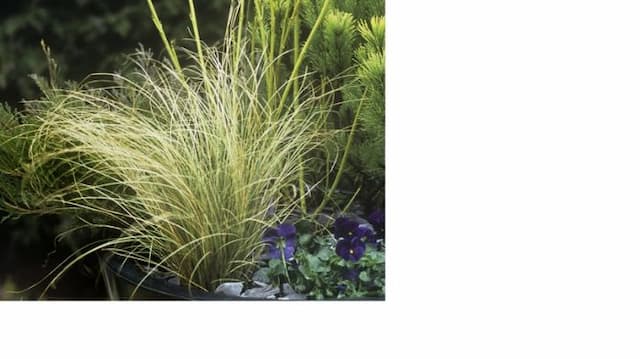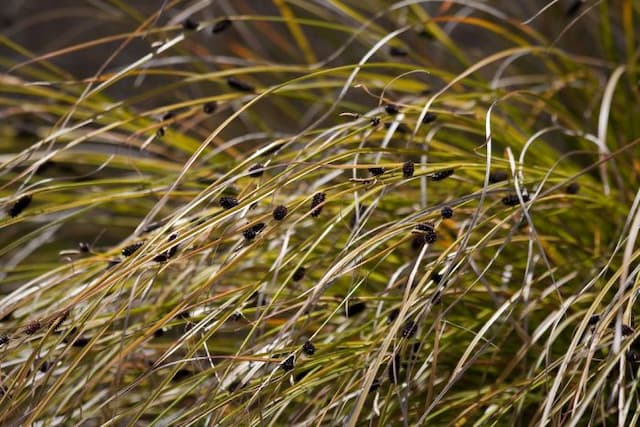Evercream Sedge Carex oshimensis Evercream = 'Ficre' (PBR) (v)

ABOUT
The plant commonly known as Carex oshimensis Evercream, or simply Evercream, presents a refined and ornamental appearance. It features a tufted, mound-forming habit with narrow, arching foliage. Each blade of grass is visually striking, displaying creamy yellow edges with a contrasting deep green center that creates a bright and variegated pattern. This vivid coloration is consistent throughout the foliage, contributing to the plant's overall lush and vibrant look that can add visual interest to any garden space. The texture of the leaves is fine, adding to the delicate and graceful aesthetic of this ornamental grass.
About this plant
 Names
NamesFamily
Cyperaceae
Synonyms
Evercolor Evercream Sedge, Variegated Sedge
Common names
Carex oshimensis 'Evercream', Carex 'Ficre'
 Toxicity
ToxicityTo humans
Carex oshimensis 'Evercream', commonly known as Evercream sedge, does not have a widely recognized status of toxicity to humans. However, as with many ornamental plants, it is not intended for ingestion. If a person were to eat parts of this plant, they might experience mild stomach upset, nausea, or vomiting. It is always recommended to keep ornamental plants out of reach of children and to avoid ingesting plant material unless it is known to be safe for consumption.
To pets
Evercream sedge, while not famously toxic to pets, should be considered potentially irritating if ingested due to its grassy, fiber-rich leaves. While the plant is not expected to be severely toxic to pets such as dogs and cats, ingestion can result in mild gastrointestinal upset including symptoms like vomiting or diarrhea. It's prudent to keep ornamental plants like this one out of reach of pets to prevent any chance of ingestion and its associated discomfort.
 Characteristics
CharacteristicsLife cycle
Perennials
Foliage type
Evergreen
Color of leaves
Variegated
Height
1-2 feet (30-60 cm)
Spread
1-2 feet (30-60 cm)
Plant type
Herb
Hardiness zones
5-9
Native area
Japan
Benefits
 General Benefits
General Benefits- Low Maintenance: Carex oshimensis Evercream is easy to care for, requiring minimal attention once established in the garden.
- Year-Round Interest: Its variegated foliage offers visual interest throughout all seasons, adding consistent beauty to landscapes.
- Drought Tolerance: Once established, it can tolerate periods of dry weather, making it suitable for drought-prone areas.
- Ornamental Appeal: With its creamy-edged leaves, this sedge provides an attractive contrast to other garden plants.
- Erosion Control: Its dense growth habit can help stabilize soil and prevent erosion on slopes or in other vulnerable areas.
- Wildlife Habitat: It can provide shelter for small wildlife and insects, contributing to biodiversity.
- Versatility: Suitable both for containers and ground planting, allowing for use in various garden designs and arrangements.
- Soil Adaptability: It can thrive in a range of soil types, from moist to well-drained, increasing its versatility as a garden plant.
- Deer Resistance: Generally resistant to deer browsing, which makes it a good choice in areas with deer populations.
- Cold Hardy: Capable of withstanding cold temperatures, it is suitable for gardens in cooler climates.
 Medical Properties
Medical PropertiesThis plant is not used for medical purposes.
 Air-purifying Qualities
Air-purifying QualitiesThis plant is not specifically known for air purifying qualities.
 Other Uses
Other Uses- Textile Dye: The leaves of Carex oshimensis, also known as Variegated Japanese Sedge, can be used to produce a natural green dye for coloring fabrics.
- Craft Material: The long, variegated leaves can be dried and used in basket weaving or for making decorative items such as wreaths and floral arrangements.
- Erosion Control: This sedge's robust root system makes it effective for stabilizing soil on slopes or in areas prone to erosion.
- Privacy Screens: When planted in clusters or rows, Variegated Japanese Sedge can create a semi-private screen in gardens or on patios.
- Garden Borders: Its distinctive foliage can outline the edges of paths, flower beds, or garden ponds, providing a lush, organized look.
- Photography Props: The plant's striking foliage can be used as a backdrop or accent in macro photography to provide contrast and interest.
- Aquarium Ornamentation: Aquarists sometimes use Variegated Japanese Sedge as an aesthetic addition to freshwater tanks, despite the plant being non-aquatic; hence it is used above water level.
- Sound Buffering: When planted densely in a garden, these sedges can help reduce ambient noise from roads or neighbors.
- Compost Material: Once the plant has reached the end of its life, the leaves and roots can be composted as they decompose well and enrich the soil.
- Winter Interest: With leaves that retain color in milder winters, Variegated Japanese Sedge adds aesthetic interest to otherwise barren winter gardens.
Interesting Facts
 Feng Shui
Feng ShuiThe plant Carex oshimensis is not used in Feng Shui practice.
 Zodiac Sign Compitability
Zodiac Sign CompitabilityThe plant Carex oshimensis is not used in astrology practice.
 Plant Symbolism
Plant Symbolism- Resilience: Carex oshimensis Evercream, commonly known as Variegated Japanese Sedge, often symbolizes resilience due to its ability to thrive in a variety of conditions, from shade to partial sunlight.
- Balance: The variegated leaves represent balance and harmony, as they maintain an equilibrium between the green chlorophyll and the cream non-pigmented sections.
- Adaptability: This plant adapts well to different soil types and moisture levels, embodying the quality of adaptability in changing environments.
- Longevity: Sedges are known for their long lifespan and persistent growth, symbolizing longevity and persistence in life.
 Water
WaterThe Evercolor 'Evercream' Sedge requires consistent moisture but doesn't like to be waterlogged. The best method is to water this plant deeply once a week, providing about one gallon per square foot of soil area. During the hotter seasons or in particularly dry climates, increase the frequency to twice a week, ensuring the soil stays evenly moist but not saturated. Always check the top inch of soil for dryness before watering to avoid overwatering. Cut back on watering during the winter, but do not let the soil completely dry out.
 Light
LightThe Evercolor 'Evercream' Sedge performs best in partial to full shade conditions. Ideal spots for this sedge are areas that receive dappled sunlight throughout the day or are shielded from the intense midday sun. Avoid placing it in full sun, as this can scorch the leaves and stress the plant.
 Temperature
TemperatureThe Evercolor 'Evercream' Sedge is hardy and can withstand temperatures as low as 20°F and as high as 120°F. However, the ideal temperature range for this sedge is between 60°F and 75°F. It can survive slight fluctuations outside these ranges but should be protected from extreme cold and heat to ensure its foliage remains vibrant and healthy.
 Pruning
PruningPruning the Evercolor 'Evercream' Sedge is mostly done to remove old or damaged foliage and to maintain a tidy appearance. Trim back the dead or yellowed leaves in early spring before new growth begins. This sedge does not need frequent pruning; doing it once a year is typically sufficient. The best time for pruning is in the spring, as it rejuvenates the plant and encourages fresh, healthy growth.
 Cleaning
CleaningAs needed
 Soil
SoilEvercolor® 'Evercream' Sedge (the common name for Carex oshimensis 'Evercream') thrives best in a soil mix that is well-drained, rich in organic matter, and consistently moist, though the plant can tolerate some drought conditions once established. An ideal mixture might consist of garden soil, compost, and some sand or perlite to improve drainage. Aim for a soil pH between 5.5 and 7 for optimal growth.
 Repotting
RepottingEvercolor® 'Evercream' Sedge typically doesn't require frequent repotting and can be done every 2-3 years or when the plant has clearly outgrown its current container. Ensure to use a slightly larger pot with good drainage holes to prevent waterlogged conditions that can lead to root rot.
 Humidity & Misting
Humidity & MistingEvercolor® 'Evercream' Sedge prefers moderate to high humidity levels but is quite adaptable and can thrive in average room humidity. To replicate its native environment, maintain a humidity level between 40-70%, but this grass-like plant is forgiving and won't suffer much if the levels are outside this range occasionally.
 Suitable locations
Suitable locationsIndoor
Place in bright, indirect light with moist soil.
Outdoor
In partial to full shade, moist, well-draining soil.
Hardiness zone
5-9 USDA
 Life cycle
Life cycleCarex oshimensis Evercream, also known as Evercream Sedge, begins its life cycle as a seed until favorable conditions allow it to germinate, typically in moist, well-drained soils. Upon germination, the seedling emerges and develops into a young plant, focusing its energy on root and foliage growth. The plant matures and forms dense clumps of variegated green and creamy white foliage, characteristic of its cultivar 'Ficre'. In its adult stage, the sedge produces inconspicuous brown flower spikes in late spring or early summer, which may lead to seed production if pollinators or environmental factors enable fertilization. The plant then enters a period of dormancy during colder months, reducing above-ground activity, but will regrow from its root system when conditions improve. Throughout its lifetime, Evercream Sedge may also propagate vegetatively through rhizomes, expanding its growth horizontally and creating new plants nearby the parent.
 Propogation
PropogationPropogation time
Spring-early summer
The Carex oshimensis 'Evercream', commonly known as Evercream Japanese sedge, is generally propagated by division since it's a patented variety, and vegetative reproduction is the standard method allowed under the plant breeders' rights. The best time to undertake this procedure is during the plant's dormant period, typically in early spring just as the new growth begins to emerge. To propagate, carefully lift the parent plant from the earth with a spade or garden fork, ensuring as much of the root system as possible is kept intact. Gently tease apart the clumps into smaller sections, making sure each has a portion of the roots. These divisions can then be immediately replanted in moist, well-draining soil, spaced about 12 to 18 inches (30 to 45 cm) apart to allow room for growth. Water the new divisions thoroughly after planting to help establish them.









